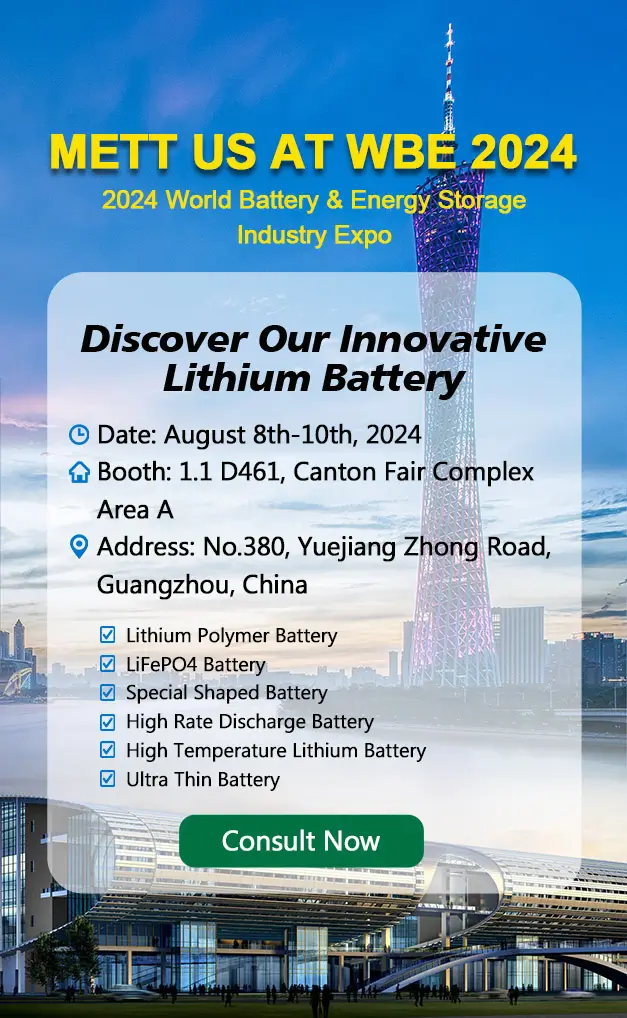Rechargeable LiPo (Lithium Polymer) batteries are a big step forward in storing energy. They can be used many times, which is better than non-rechargeable batteries. These batteries are changing different industries because they are good for the environment and save money.
Part 1. Rechargeable LiPo battery
Rechargeable Lithium Polymer (LiPo) batteries are a big improvement in storing energy for things we use. They are light, hold a lot of energy, and can be used in many electronic devices. Knowing how they work helps us understand why they are used a lot in different industries.
Rechargeable LiPo battery chemistry
1. Anode and cathode composition
LiPo batteries have a special mix in their anode and cathode. The cathode is usually made of lithium cobalt oxide or other types like lithium manganese oxide or lithium nickel manganese cobalt oxide. The anode is often carbon, like graphite. This mix helps lithium ions move well during charging and using.
2. Separator
The separator in LiPo batteries is important for safety. It stops short circuits and lets lithium ions move. It’s made of a special porous material that keeps the anode and cathode apart but still lets ions go through.
3. Electrolyte
Unlike regular batteries with liquid inside, LiPo batteries have a special solid or gel-like electrolyte. This makes them safer, and you can design them in different shapes. The solid electrolyte also lowers the chance of problems with leaks.
Part 2. Non-rechargeable battery (Primary Battery)
Non-rechargeable batteries, also known as primary batteries, are made for one-time use. They have chemicals that don’t allow them to be charged again. They give power only one time.
Non-rechargeable battery chemistry
1. Alkaline battery
These batteries have zinc and manganese parts separated by a special liquid called alkaline. When these parts react with each other, they make electricity.
2. Carbon-zinc battery
These batteries have zinc and manganese parts too, with a liquid called electrolyte. When these parts react, they change chemical energy into electricity.
3. Lithium battery
This battery is not for recharging. It uses lithium and different materials for its parts. The liquid inside has lithium too. It makes electricity through chemical reactions.
Part 3. Rechargeable LiPo battery pros and cons
Pros:
-
High energy density: LiPo batteries offer higher energy density compared to many other rechargeable batteries, providing longer-lasting power for various devices.
-
Lightweight and compact: They are lightweight and can be made in various shapes and sizes, making them versatile for portable electronics and gadgets.
-
Quick recharge: LiPo batteries generally have faster recharge times compared to other rechargeable batteries.
-
Customizable: The flexible construction allows for customization in size and shape to fit specific device requirements.
-
High discharge rates: Suited for applications requiring high discharge rates, like RC models and drones.
Cons:
-
Safety risks: Prone to damage, punctures, and overcharging, which can result in thermal runaway or even explosion.
-
Lifespan: LiPo batteries have a limited lifespan, and their performance deteriorates over time and charge cycles.
-
Maintenance required: They need proper care, storage, and balancing to maintain performance and safety.
-
Sensitive to temperature: Extreme temperatures can affect their performance and lifespan, requiring careful handling in varied climates.
-
Cost: Initial costs might be higher compared to some other rechargeable batteries.
Part 4. Non-rechargeable battery pros and cons
Pros:
-
Long shelf life: Non-rechargeable batteries offer a longer shelf life, maintaining their charge over extended periods.
-
Lower cost: Generally more affordable initially compared to rechargeable batteries.
-
Ease of use: No charging is required; they are ready to use straight out of the package.
-
Durability: Can withstand long periods of storage without substantial capacity loss.
-
Wider operating temperatures: Tolerate a broader range of temperatures without significant performance loss.
Cons:
-
Single-use: Once depleted, they must be replaced and cannot be recharged.
-
Environmental impact: Disposing of non-rechargeable batteries can contribute to environmental pollution due to the chemicals they contain.
-
Limited applications: Less versatile than rechargeable batteries, especially in devices requiring frequent use.
-
Low energy density: Generally have lower energy density than rechargeable counterparts.
-
Voltage variability: Voltage output gradually decreases as the battery depletes, impacting device performance.
Part 5. Rechargeable LiPo battery applications
Rechargeable Lithium Polymer (LiPo) batteries find extensive applications across various industries due to their unique characteristics and capabilities.
1. Consumer electronics:
LiPo batteries are widely used in consumer electronics, powering smartphones, tablets, laptops, and wearable devices due to their high energy density and lightweight nature. They provide longer usage periods and flexibility in design for these portable gadgets.
2. Remote control models:
RC hobbyists extensively use LiPo batteries for remote-controlled cars, planes, drones, and helicopters. These batteries offer high discharge rates, making them suitable for providing the necessary power to these models.
3. Electric vehicles:
In the automotive sector, electric vehicles (EVs) utilize LiPo batteries due to their high energy density, enabling longer driving ranges on a single charge. They play a crucial role in the advancement of electric mobility.
4. Aerospace and aviation:
The aviation industry leverages LiPo batteries for unmanned aerial vehicles (UAVs) and model aircraft due to their lightweight build and high energy storage capacity.
5. Medical devices:
Medical devices such as portable monitors, infusion pumps, and other portable medical equipment benefit from LiPo batteries for their compact size and energy efficiency.
6. Energy storage systems:
LiPo batteries are also used in energy storage systems for renewable energy sources like solar and wind power, providing backup power and storing excess energy for later use.
7. Portable power banks:
These batteries power portable chargers or power banks, allowing users to recharge smartphones and other devices on the go.
8. E-cigarettes and vaping devices:
LiPo batteries are often used in vaping devices due to their ability to deliver high currents safely.
Part 6. Non-rechargeable battery applications
Non-rechargeable batteries, renowned for their longer shelf life and higher initial voltage output compared to rechargeable counterparts, have a diverse range of applications across different domains.
1. Consumer electronics:
Primary batteries are commonly used in low-drain devices such as remote controls, wall clocks, and basic digital cameras. Their longer shelf life makes them ideal for devices that aren’t frequently used but require long-lasting power.
2. Smoke detectors and alarms:
The extended shelf life of non-rechargeable batteries makes them suitable for essential safety devices like smoke detectors and alarms, guaranteeing long-lasting power reliability.
3. Military and aerospace:
In critical applications such as military equipment, non-rechargeable batteries serve as dependable power sources for communication devices, night-vision goggles, and other mission-critical equipment.
4. Emergency equipment:
Flashlights, emergency radios, and portable chargers frequently utilize non-rechargeable batteries to ensure immediate, dependable power in emergencies.
5. Automobiles:
Primary batteries often power remote car key fobs and certain automotive devices where a long lifespan without recharging is valued.
6. Toys and games:
In toys and games with minimal power requirements, like some handheld gaming devices or toys with simple electronics, non-rechargeable batteries provide extended usage without frequent replacements.
Part 7. FAQs
-
Are rechargeable or non-rechargeable batteries bettery?
It depends on the application. Rechargeable batteries are more cost-effective and eco-friendly in the long run, while non-rechargeable batteries often offer higher initial capacity and longer shelf life for infrequent use. -
What happens if you charge non-rechargeable lithium batteries?
Charging non-rechargeable lithium batteries can lead to overheating, leakage, or even explosion due to their design not being intended for recharging, posing safety risks. -
Do rechargeable batteries drain faster than regular batteries?
Rechargeable batteries may have slightly higher self-discharge rates, causing them to lose charge over time when not in use compared to some non-rechargeable batteries. However, the rate varies between battery types. -
Which type of rechargeable battery lasts the longest?
Lithium-ion batteries typically offer a longer lifespan than rechargeable batteries, providing more charge cycles and better capacity retention over time compared to NiMH or NiCd batteries. -
Which is better, Li-ion or NiMH or NiCd?
Lithium-ion (Li-ion) batteries are often preferred due to their higher energy density, lighter weight, and longer cycle life compared to Nickel Metal Hydride (NiMH) or Nickel Cadmium (NiCd) batteries. NiMH and NiCd have their advantages but are less commonly used due to environmental concerns and lower energy density.
Related Tags:
More Articles

Overview of Deep Cycle Lithium Battery
In this article, we explore the life, voltage, capacity, and charging considerations of deep cycle lithium batteries.
How Long do Lithium Batteries Last?
How long do lithium batteries last? we will explore the factors that influence the lifespan of lithium batteries and provide insights into their longevity.
How to Choose the Best LiFePO4 Battery?
Choose LiFePO4 batteries for superior performance, safety, and versatility in EVs, UPS, and backup power. This guide helps you make informed decisions.
Get 12v Lithium Car Battery As a Power Source for the Ride
Make the right choice for your vehicle's battery needs by installing a 12 volt lithium car battery. You will enjoy maintenance-free longevity with this change.
Everything About A Small Lithium Ion Battery
Discover the features, uses & future potential of a small lithium ion battery. A compact and tiny powerhouse ideal for smartphones, wearables, drones & more.





